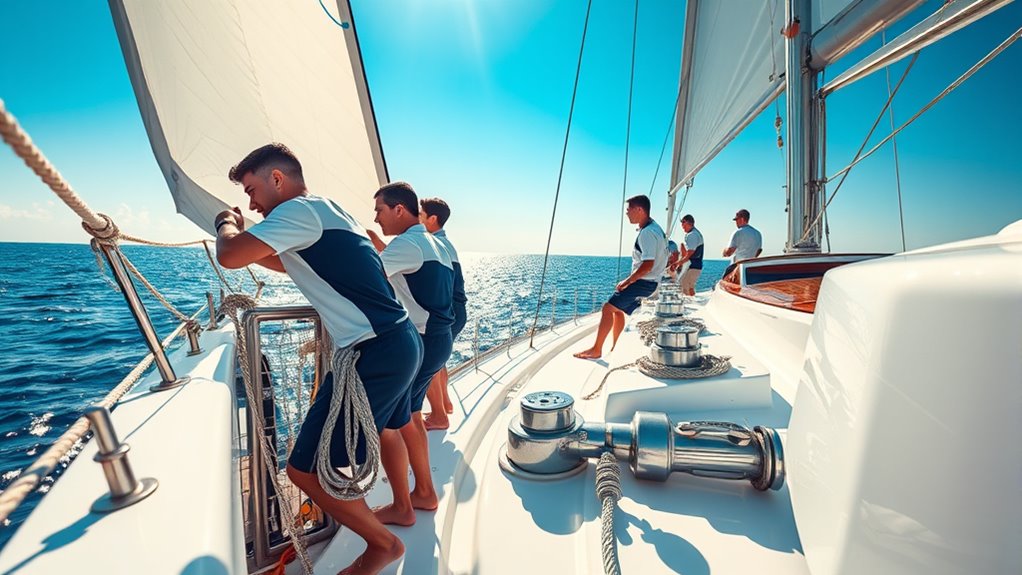Spending a week on a yacht to learn sailing lets you gain hands-on experience with navigation, safety, and crew roles like deckhand or stewardess. You’ll practice knot tying, line handling, and maneuvering the vessel, all while improving teamwork and communication skills. With basic safety training and an understanding of yacht operations, you’ll build confidence on deck. Keep exploring to discover how to make the most of your sailing adventure and grow your skills further.
Key Takeaways
- Participate in hands-on sailing lessons to learn navigation, sail handling, and safety procedures during your yacht vacation.
- Assist crew with docking, anchoring, and line handling to gain practical seamanship experience.
- Receive personalized instruction on boat operations, including engine maintenance and emergency protocols.
- Engage in safety drills like man overboard and fire response to build confidence and preparedness.
- Enjoy a luxurious, educational experience combining leisure with sailing skills tailored for vacationers.
Understanding the Basics of Yacht Operations
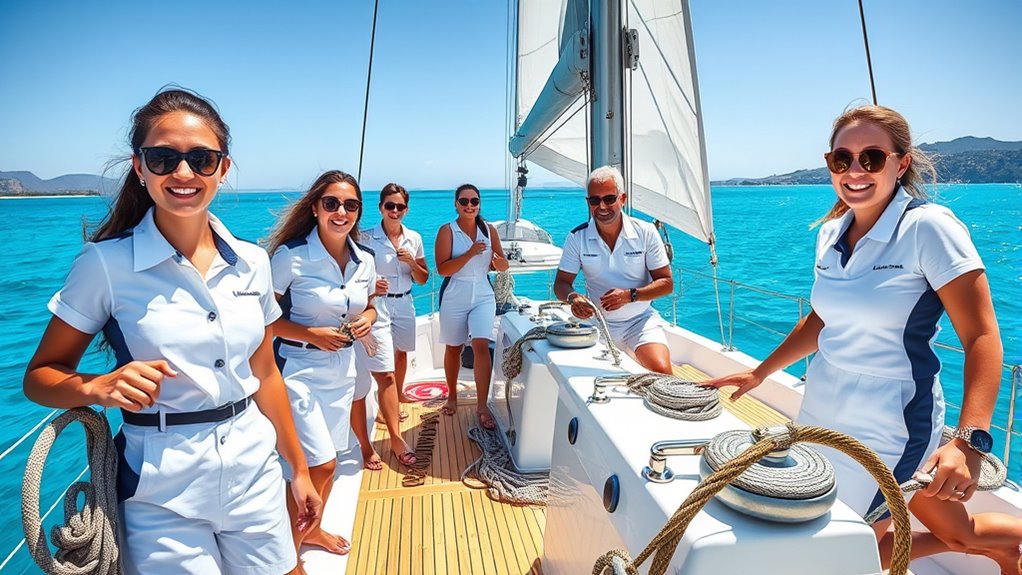
Understanding the basics of yacht operations is vital for safe and efficient navigation. You need to familiarize yourself with marine navigation techniques, including reading nautical charts, recognizing buoy colors and shapes, and understanding maritime rules like right of way. Modern yachts feature advanced navigation systems, but knowing how to operate a compass is still valuable. Equally important is engine maintenance; you should be comfortable monitoring oil, coolant, and battery levels to prevent breakdowns. The helm is your control center, combining steering, throttle, and navigation controls. Knowing the layout of safety equipment such as life jackets and fire extinguishers is fundamental. By mastering these fundamentals, you’ll ensure smooth sailing and respond effectively to any operational challenges on board. Practicing regularly helps reinforce your understanding and builds confidence in handling the yacht under various conditions. Developing a good understanding of navigation tools enhances your ability to chart courses accurately and respond to changing conditions at sea.
Essential Safety Protocols for Aspiring Crew
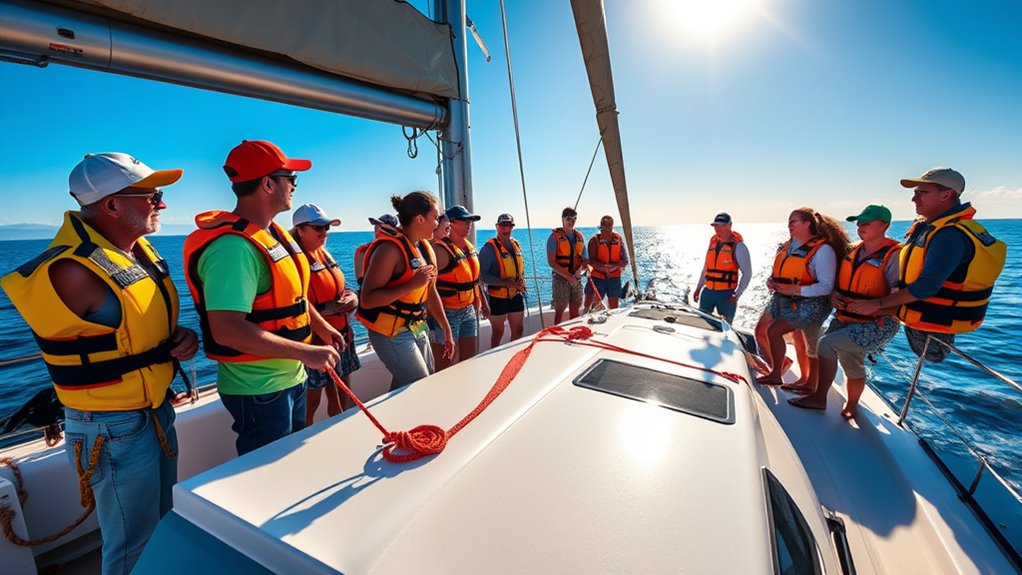
Ensuring safety on a yacht requires strict adherence to essential protocols that protect everyone onboard. You must wear properly fitted life jackets and PFDs during emergencies and keep fire extinguishers, first aid kits, and signaling devices accessible. Regular safety drills simulate man overboard, fire, or medical emergencies, reinforcing response skills. Always test emergency communication systems for reliability. Proper yacht maintenance includes keeping decks clean and free of clutter, using non-slip footwear, and following safety procedures during operations like docking or line handling. Be vigilant about marine pollution by avoiding discharges and maintaining eco-friendly practices. Monitoring weather and navigation tools helps prevent accidents. Staying physically fit and mentally prepared ensures you can respond effectively, making safety a shared responsibility on your voyage. Additionally, vessel inspections should be conducted regularly to identify and address potential safety issues before they escalate. Maintaining a well-stocked First aid kit and knowing basic medical procedures can be lifesaving in remote or emergency situations.

Mastering the skills of a deckhand and stewardess is essential for smooth yacht operations and exceptional guest experiences. As a deckhand, you’ll handle vessel maintenance tasks like cleaning, polishing, sanding, and minor repairs that keep the yacht in top condition. Operating deck equipment and assisting with docking and anchoring require seamanship and physical stamina. On the other hand, stewardesses focus on interior guest service, ensuring cabins and communal areas are spotless and inviting. Both roles demand attention to detail, teamwork, and effective communication to foster crew camaraderie. Your ability to perform routine maintenance and provide seamless service directly impacts the yacht’s operational readiness and guest satisfaction. Developing these skills ensures a cohesive crew environment and smooth sailing from deck to interior. Proper training and certifications are crucial for ensuring safety and efficiency in both roles, and gaining experience can open pathways to advanced positions within the yacht industry.
The Importance of STCW Certification and Safety Training
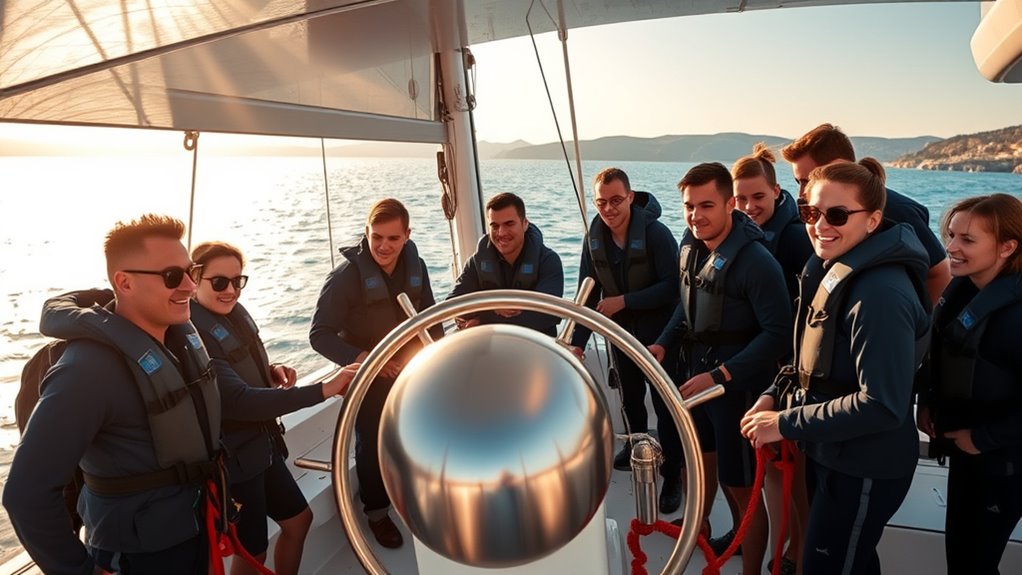
Why is STCW certification so essential for yacht crew members? It’s the key to complying with maritime law and ensuring safety onboard. This certification confirms you’re trained in safety equipment use, emergency response, and security protocols, crucial for any maritime operation. Without it, yacht crew agents won’t facilitate your employment, and yachts can face legal and insurance issues. Here’s a quick overview:
| Certification Area | Focus | Validity |
|---|---|---|
| Basic Safety Training | Fire fighting, first aid, survival | 5 years |
| Emergency Response | Hazards, drills | Recurrent refresher |
| Maritime Law | Compliance standards | Ongoing |
| Safety Equipment | Proper use | Always current |
| Security Awareness | Threat detection | Continuous |
This hands-on training promotes safety culture, reduces accidents, and keeps you legally compliant in international waters. STCW certification is recognized worldwide, ensuring your skills meet international standards and improving your employability on various vessels. Additionally, staying current with ongoing training requirements helps maintain a high safety standard throughout your career.
Practical Skills You Can Learn in a Short Course
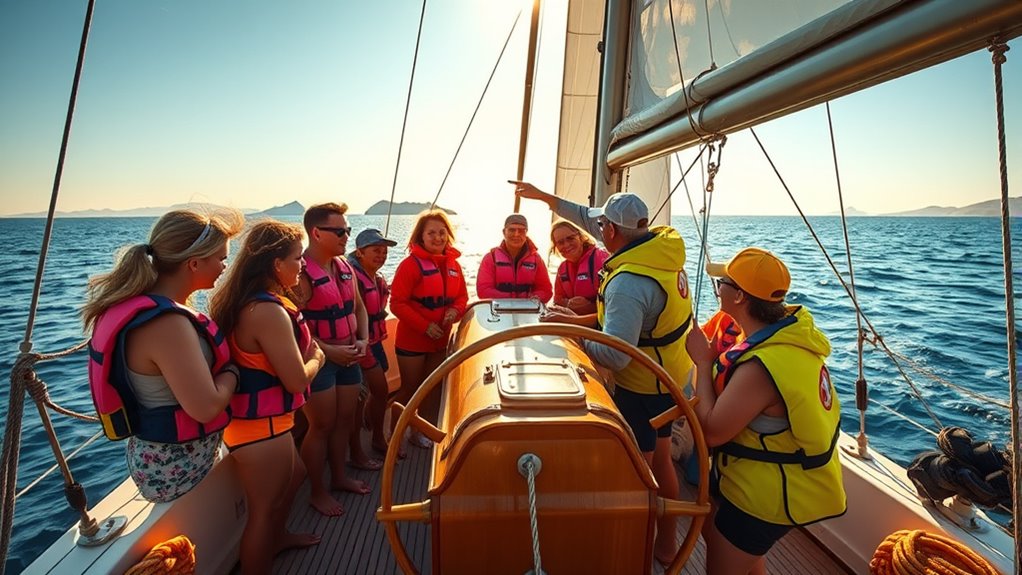
In just a short course, you can quickly pick up essential sailing skills like knot tying, sail trimming, and boat handling. You’ll also learn crucial safety procedures, from emergency communication to reefing sails in rough weather. These practical skills give you confidence to manage a yacht effectively and safely in real situations. Additionally, understanding local weather patterns and performing pre-sailing inspections are vital for a safe voyage. Knowing how to select the right suitable planters can also enhance your onboard environment, creating a more comfortable and aesthetically pleasing space.
Basic Sailing Techniques
Getting comfortable with basic sailing techniques is essential for anyone new to the water, and a short course can quickly build your confidence and skills. One key skill is sail trim, which involves adjusting sheets to shape the sails for ideal performance. Proper rig adjustment, such as tensioning the vang or downhaul, helps control sail shape and responsiveness. You’ll learn to recognize how sails should look in different wind conditions and how to make quick, precise adjustments. Managing sail luffing and understanding the “No-Go Zone” improve your efficiency when sailing close-hauled. These techniques allow you to respond effectively to changing winds, keep the boat balanced, and ensure smoother maneuvers. With practice, you’ll develop the confidence to handle the boat confidently and enjoy your time on the water. Mastering key sailing terminology also enhances communication with crew members and helps prevent mishaps during your voyage. Developing an understanding of sailboat anatomy provides a solid foundation that makes learning advanced skills easier and more intuitive.
Safety and Emergency Skills
Are you prepared to handle emergencies on the water? Safety and emergency skills are essential for any sailor. You’ll learn marine communication techniques to signal for help and coordinate rescue efforts. Familiarity with emergency evacuation procedures ensures you can abandon ship safely when needed, including proper timing and methods. Personal survival techniques cover using life jackets, immersion suits, and survival craft to stay afloat and protected in harsh conditions. You’ll also practice deploying life rafts, righting capsized vessels, and conducting search and rescue operations. Fire prevention and firefighting skills help you identify fire hazards and respond swiftly with the correct extinguishers. The course provides comprehensive training that meets international standards, ensuring you are prepared for various emergencies. These practical skills boost your confidence, enabling you to act decisively and keep everyone safe during unforeseen incidents on the water.
Enhancing Guest Service and Hospitality Abilities
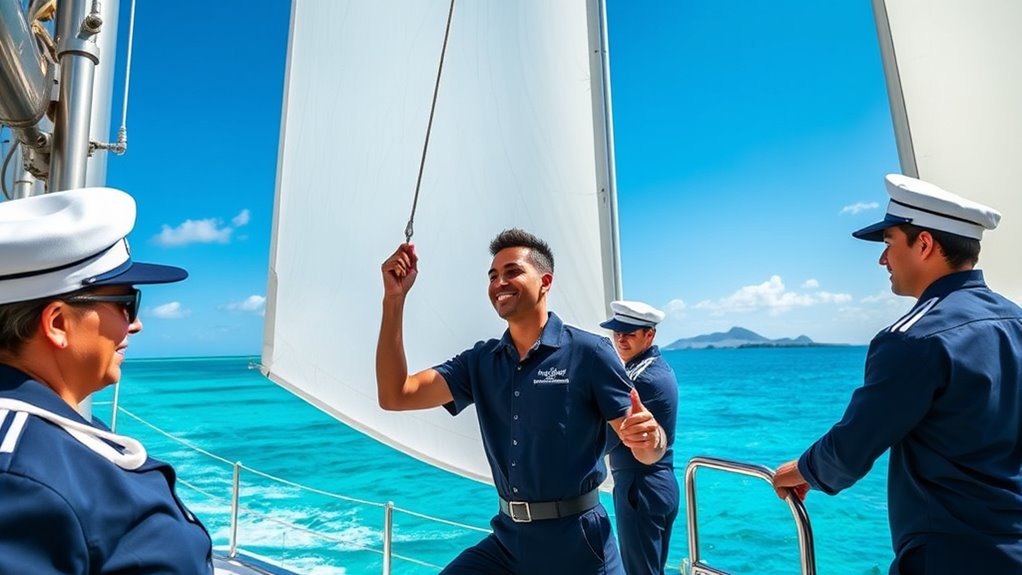
To truly impress guests, you need polished service etiquette and strong communication skills that make them feel valued. Personalizing each experience shows attention to detail and creates memorable moments. By mastering these abilities, you elevate your hospitality game and guarantee guests leave satisfied. Incorporating guest preferences can further enhance their overall experience.
Polished Service Etiquette
Polished service etiquette is essential for creating a luxurious and comfortable experience on board. Your demeanor sets the tone, so always remain courteous and respectful to both guests and crew. Pay attention to details like your crew wardrobe and presentation, which reflect professionalism. Offering attentive service with a genuine smile enhances the guest experience. Additionally, understanding service etiquette nuances ensures seamless interactions and elevates overall guest satisfaction.
| Aspect | Best Practice |
|---|---|
| Luxury Amenities | Anticipate needs and present amenities seamlessly. |
| Crew Wardrobe | Keep uniforms tidy and appropriate for the occasion. |
| Guest Interaction | Be discreet, attentive, and respectful at all times. |
Maintaining cleanliness and order, managing noise levels, and respecting private spaces elevate service standards. Express gratitude regularly, and remember that small gestures of courtesy create a memorable, polished onboard atmosphere.
Effective Communication Skills
Effective communication skills are essential for delivering exceptional guest service and creating a welcoming onboard atmosphere. When steering marine weather conditions or handling vessel maintenance, clear communication keeps everyone safe and informed. Pre-manoeuvre briefings help you and your crew discuss tasks, sequences, and risk mitigation, reducing misunderstandings. Establishing verbal and non-verbal signals ensures safety during delicate operations, especially at vulnerable positions like the bow or mast. In noisy environments, repeating messages, using gestures, or increasing volume prevents miscommunication. Maintaining eye contact and actively listening to your crew fosters trust and quick problem-solving. When stress levels rise, effective communication helps manage tensions and coordinate responses. Mastering these skills enhances teamwork, safety, and overall guest experience onboard. Additionally, incorporating visualization techniques can help crew members stay focused and confident during challenging situations, promoting a more positive onboard atmosphere.
Personalized Guest Experiences
Have you ever wondered how personalized touches can transform a guest’s experience onboard? Mastering tailored service makes all the difference in creating memorable moments. Your training emphasizes luxury amenities and culinary presentation, allowing you to deliver refined, bespoke experiences. Focus on:
- Customized drinks and food to suit guest preferences, elevating their dining experience.
- Flower arrangements and table tuning that set a unique ambiance for each charter.
- Ceremonial services, like wine decanting and cigar presentation, adding sophistication and personalization.
- Incorporate rustic decor elements to reflect a cozy, farmhouse-inspired aesthetic that can add warmth and charm to the environment.
Hands-On Experience: Maneuvering and Handling Lines

Mastering line handling on a yacht requires precise, deliberate actions to guarantee safety and efficiency. Proper line coiling involves rolling the hand to lay the twist, creating neat, easily deployable coils. Using a locking loop or a French pocket knot keeps the coil secure and ready for quick release. Leaving extra line at the start of the coil helps hook or cleat the line swiftly after use. When it’s time to throw a line, prepare two coils—large in the left hand and smaller in the right—for a smooth, straight release. Accurate line throwing minimizes jumping ashore and speeds up docking. Whether tossing to shore or another vessel, practicing to throw both short and long distances enhances your versatility, making handling lines safer and more efficient on deck. Proper technique and familiarity with safety procedures ensure everyone remains protected during maneuvers.
Building Teamwork and Communication on Deck and Below Deck

Building strong teamwork and communication on deck and below deck is essential for safe and efficient yacht operations. Embracing crew diversity boosts problem-solving and decision-making, creating a more adaptable team. Clear, honest communication helps prevent misunderstandings and builds trust. To improve teamwork, consider these key strategies:
- Conduct regular check-ins and team-building activities to foster mutual support.
- Use conflict resolution training to equip everyone with skills to handle disagreements constructively.
- Implement mentorship programs that pair experienced crew with newcomers, encouraging growth and belonging.
Additionally, understanding the importance of effective communication can significantly enhance crew cohesion and operational success.
Navigating the Yachting Industry and Career Opportunities
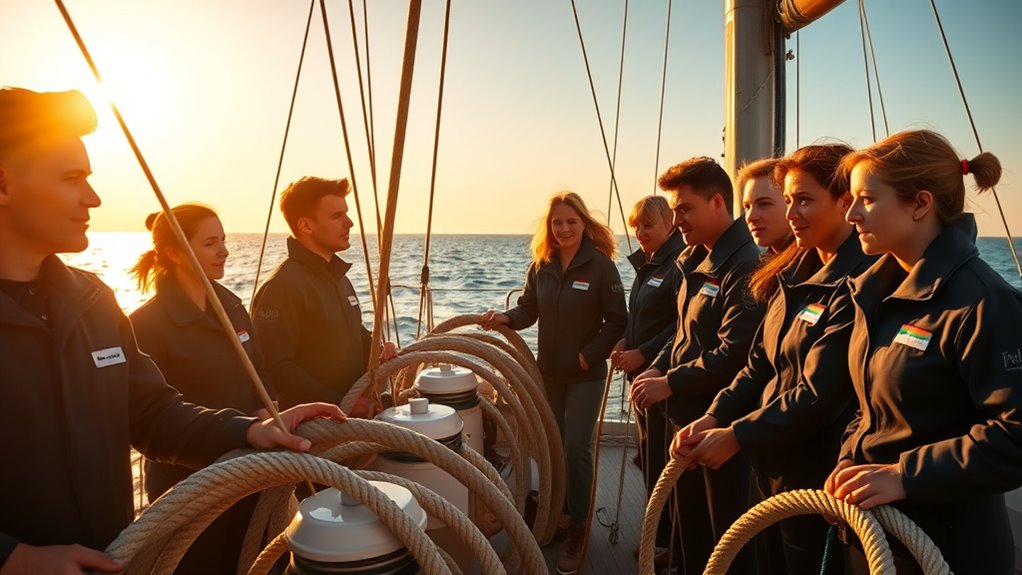
Understanding the yachting industry requires grasping its structured hierarchy, diverse career paths, and the skills needed to succeed. You’ll find roles across departments like Deck, Engineering, Interior, and Galley, with clear progression from entry-level positions to senior roles such as captain or chief stewardess. Salaries vary widely, influenced by yacht size, experience, and rotation systems, with captain pay reaching €16,000+ on larger vessels. The industry emphasizes formal certifications like STCW and multi-skilled crew members who can adapt across roles. Industry trends include adopting crew rotation models to improve work-life balance. Additionally, understanding luxury yacht design and its environmental impact is key for future sustainability. Vetted opportunities are ample, but staying adaptable and connected through networks is vital for long-term career growth.
Preparing for Future Sailing Adventures and Professional Growth

Preparing for your future sailing adventures and professional growth starts with obtaining the necessary certifications and maintaining your skills. You’ll need up-to-date STCW Basic Safety Training, valid medical certificates, and certifications in yacht maintenance or specialized courses. These credentials guarantee compliance with marine environmental regulations and safety standards, boosting your employability.
Consider these steps:
- Keep your STCW certification current with refresher courses every five years.
- Pursue advanced training in yacht maintenance and navigational skills to enhance versatility.
- Stay informed about marine environmental regulations to ensure compliance and demonstrate professionalism.
- Regularly review and deepen your understanding of dream symbols, as they can offer valuable insights into your subconscious attitudes toward your career and personal growth.
Frequently Asked Questions
What Are the Prerequisites for Enrolling in Yacht Crew Training Courses?
You need to meet basic prerequisites to enroll in yacht crew training courses. Make certain your crew attire is appropriate for safety and comfort, and check if language requirements are met, often needing English proficiency. Typically, you’re at least 16 years old with no prior experience required for entry-level courses. Ensure you have a valid medical certificate, passport, and book your course in advance at a certified provider.
How Do Online Modules Complement Practical Hands-On Sailing Experience?
You’ll find online modules perfectly complement practical sailing by offering virtual simulations and online assessments that build your theoretical knowledge. These tools reinforce core concepts before you hit the water, making hands-on experience more effective. When you combine online learning with real-world practice, you gain confidence and skills faster, ensuring you’re well-prepared to handle on-water challenges. This integrated approach maximizes your learning and safety during sailing adventures.
Can Short Courses Lead to Full-Time Yachting Careers?
Imagine you’re stepping onto a yacht like a seasoned sailor, ready to navigate today’s maritime law and crew etiquette. Short courses can help you land entry-level jobs, but they rarely lead to full-time careers alone. To advance, you need practical experience, formal certification, and ongoing training. Combining these elements boosts your skills and employability, making you a valuable crew member for long-term success in the yachting industry.
What Safety Certifications Are Recognized Internationally for Yacht Crew?
You need to know that international safety certifications, like the STCW Basic Safety Training, are recognized under maritime regulations globally. These certifications guarantee you’re well-versed in safety management systems onboard yachts. They cover essential skills such as fire fighting, sea survival, and first aid. Maintaining valid certifications, including refresher courses, is vital for compliance and safe operations, especially on larger vessels governed by strict safety standards.
How Can I Transition From Vacation Sailing to Professional Yacht Employment?
Imagine sailing for fun today, then steering a professional yacht tomorrow. To make that leap, you need crew qualifications like STCW and OOW certifications. Focus on gaining experience, seeking mentorship, and understanding industry expectations. Prioritize career progression by pursuing training, building skills, and exploring shore-based roles. This shift requires dedication, but with the right qualifications and mindset, you can turn your vacation sailing into a rewarding professional yachting career.
Conclusion
By learning the basics, practicing safety, and honing your skills, you open the door to new adventures. You build confidence, foster teamwork, and embrace growth both on deck and below. You prepare for future voyages, pursue professional opportunities, and discover your passion for sailing. In embracing these experiences, you don’t just learn to sail—you sail toward a future of endless possibilities and personal achievement. Your journey begins now, with every wave and every lesson.
